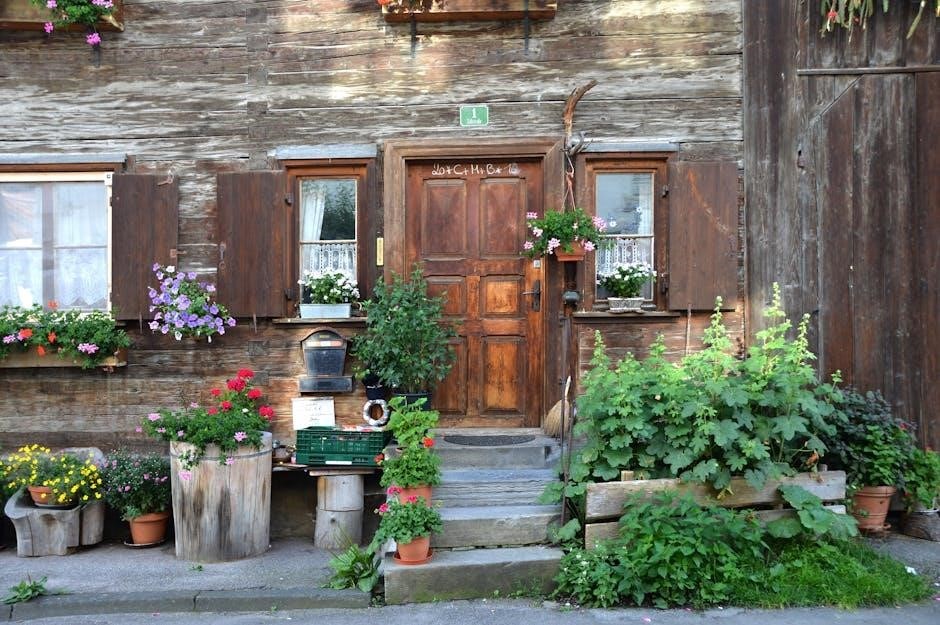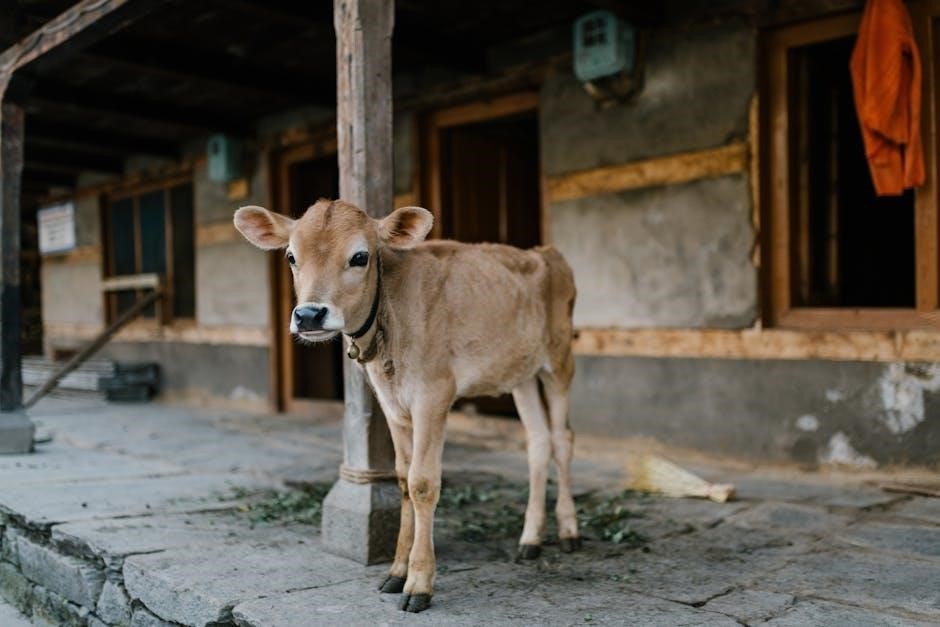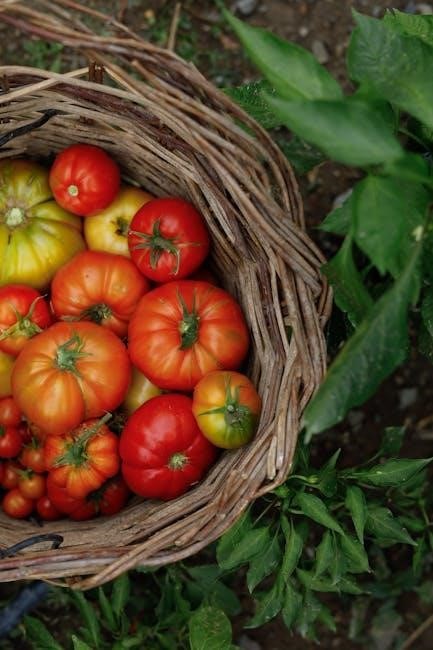Homesteading is a lifestyle focused on self-sufficiency, sustainability, and independence. It involves growing food, raising animals, and preserving resources to create a thriving, eco-friendly home environment. Empowering individuals to live off the land, homesteading encourages mindfulness of consumption and fosters a deeper connection with nature and community. It’s a journey toward resilience and simplicity, offering fulfillment through hard work and creativity. Whether in rural or urban settings, homesteading adapts to diverse circumstances, making it accessible to everyone willing to embrace this meaningful way of life.
1.1 What is Homesteading?
Homesteading is a lifestyle centered on self-sufficiency and sustainability, where individuals or families produce their own food, manage resources, and reduce reliance on external systems. It involves activities like gardening, raising animals, and preserving food, often on a small scale. Homesteading is not a business but a personal choice to live more independently. It emphasizes hands-on labor, DIY projects, and a connection to the land. While it can be practiced in rural areas, urban homesteading is also possible, adapting techniques to smaller spaces. At its core, homesteading is about creating a resilient, eco-friendly way of life that fosters mindfulness and fulfillment.
1.2 Benefits of Homesteading
Homesteading offers numerous benefits, including fresh, organic food, reduced reliance on public utilities, and significant cost savings. It fosters self-reliance, empowerment, and a deeper connection to nature. By growing and preserving food, homesteaders gain control over their diet and reduce dependence on industrial systems. This lifestyle also promotes environmental sustainability by minimizing waste and using renewable resources. Homesteading encourages creativity, resourcefulness, and a sense of accomplishment. Additionally, it can strengthen community ties through shared knowledge and support. Whether in rural or urban settings, homesteading provides a fulfilling way to live more sustainably and independently.

Getting Started with Homesteading
Assess your property needs, set achievable goals, and start small. Budget wisely, embrace DIY projects, and gradually build towards a self-sufficient lifestyle.
2.1 Assessing Your Property Needs
Evaluating your property is crucial for a successful homestead. Start by listing your needs, such as space for gardening, livestock, and water sources. Consider soil quality, climate, and accessibility. No property is perfect, so prioritize your must-haves and be flexible. Research local zoning laws and ensure your land aligns with your goals. Whether urban or rural, understanding your property’s potential is the first step toward creating a sustainable homestead. This assessment will guide your decisions and help you make the most of your available resources.
2.2 Setting Realistic Goals for Your Homestead
Setting realistic goals is essential for a successful homestead. Start by assessing your resources, skills, and time. Prioritize what matters most, whether it’s food production, animal raising, or sustainability. Break larger goals into smaller, manageable steps to avoid overwhelm. Remember, homesteading is a journey, not a race. Be patient and flexible, as challenges will arise. Celebrate progress, no matter how small, and stay committed to your vision. A well-planned approach ensures long-term success and fulfillment in your homesteading endeavors.
Key Components of a Successful Homestead
A successful homestead thrives on sustainable gardening, efficient food production, and skilled animal husbandry. Food preservation techniques ensure year-round resources, fostering self-reliance and environmental harmony in daily life.
3.1 Gardening and Food Production
Gardening is the cornerstone of homesteading, providing fresh, nutritious food while promoting sustainability. Start by assessing your land and climate to determine the best crops for your area. Consider raised beds, no-till gardening, or permaculture designs to maximize space and reduce labor. Plant a variety of fruits, vegetables, and herbs to ensure a diverse harvest; Regularly test and amend soil to maintain fertility. Incorporate compost and natural fertilizers to avoid chemicals. Seasonal crop rotation and companion planting can enhance yields and deter pests. This approach not only feeds your family but also fosters a deeper connection with the land and nature.
3.2 Raising Animals for Food and Labor
Raising animals is a vital part of homesteading, providing a sustainable source of food and labor. Chickens offer eggs and meat, while cows, goats, or sheep supply milk and dairy products. Larger animals like oxen or horses can assist with farming tasks, reducing reliance on machinery. Pigs are excellent for converting scraps into meat, and bees contribute honey and pollination. Each species requires specific care, including suitable housing, feed, and veterinary attention. Homesteaders must consider space, time, and resources when selecting animals, ensuring they align with their goals and capabilities. This integration of animals enhances productivity and self-reliance while fostering a balanced ecosystem.
3.3 Food Preservation Techniques
Food preservation is essential for maintaining a steady food supply throughout the year. Techniques like canning, freezing, dehydrating, and fermenting allow homesteaders to enjoy their harvest long after the growing season ends. Canning preserves fruits, vegetables, and meats in airtight containers, while freezing maintains nutrients by locking in freshness. Dehydrating removes moisture, preventing spoilage and reducing storage space. Fermenting enhances flavor and nutritional value, creating items like sauerkraut and yogurt. Additionally, root cellars and smokehouses provide natural storage solutions. These methods ensure sustainability, reduce waste, and offer healthy, wholesome food options year-round, aligning with the homestead’s goal of self-sufficiency.

Financial and Legal Considerations
Homesteading requires careful budgeting and understanding of legal frameworks. Property taxes, zoning laws, and permits must be navigated to ensure compliance. Financial planning helps manage expenses, while tax exemptions and incentives can reduce costs. Legal knowledge protects land rights and ensures sustainable practices. Proper estate planning and insurance are also crucial for long-term security and legacy. Balancing finances and legal obligations is key to maintaining a thriving homestead.
4.1 Budgeting for Homestead Expenses
Budgeting is crucial for managing homestead expenses. Start by assessing income sources and prioritizing needs over wants. Allocate funds for seeds, tools, and animal care. Track expenses to avoid overspending. Consider long-term investments like renewable energy or livestock. Plan for unexpected costs by building an emergency fund. Regularly review and adjust the budget to reflect changing needs. Avoid debt by focusing on sustainable practices. Prioritize DIY projects to reduce costs. Budgeting ensures financial stability, allowing homesteaders to thrive without compromising their lifestyle. Proper planning helps balance expenses and income, fostering a self-sufficient and resilient homestead.
4.2 Understanding Homestead Laws and Exemptions
Homestead laws vary by location and offer legal protections for homeowners. These laws often provide tax exemptions or deductions, reducing financial burdens. Understanding local regulations is essential for maximizing benefits. Some areas allow homestead exemptions, lowering property taxes. Additionally, homestead laws can protect a portion of your property from creditors. Researching state-specific laws ensures compliance and optimization of benefits. Consulting local authorities or legal experts can clarify eligibility and application processes. Staying informed about homestead laws helps safeguard your property and financial investments, ensuring long-term stability for your homestead. Knowledge of these laws is a cornerstone of responsible homestead management.

Building a Self-Sufficient Lifestyle
Building a self-sufficient lifestyle involves embracing sustainable practices, renewable energy, and DIY projects. It empowers individuals to reduce reliance on external systems, fostering eco-friendly living and resilience. Key elements include energy independence, waste reduction, and resourcefulness, creating a balanced and fulfilling homestead. This approach encourages creativity, hard work, and a deeper connection to the environment, ensuring long-term sustainability for generations to come.
5.1 Renewable Energy Options for Homesteads
Renewable energy is a cornerstone of a self-sufficient homestead, reducing reliance on public utilities and lowering costs. Solar power is a popular choice, using photovoltaic panels to harness sunlight for electricity. Wind energy is another viable option, especially in areas with consistent breezes. Hydropower can be utilized if you have access to a stream or river. Additionally, geothermal systems leverage the Earth’s stable temperature for heating and cooling. Biogas generators convert organic waste into fuel, offering a sustainable solution for cooking and heating. These options not only reduce your carbon footprint but also provide long-term energy independence and cost savings.
5.2 DIY Projects to Enhance Sustainability
Diy projects are essential for creating a sustainable homestead. Start by composting kitchen scraps and animal manure to fertilize your garden. Install a rainwater collection system to conserve water for irrigation and household use. Upcycle old containers into planters or storage solutions. Build a root cellar to store harvested food, reducing the need for refrigeration. Create natural cleaning products using household items like vinegar and baking soda. These projects not only reduce waste and costs but also foster creativity and self-reliance, helping you live a more eco-friendly and independent lifestyle.

Community and Support
Building connections with other homesteaders fosters sharing of knowledge, resources, and encouragement. Online forums, local workshops, and community events provide invaluable support and inspiration for homesteaders.
6.1 Building a Homesteading Community
Building a homesteading community involves fostering connections with like-minded individuals. Online forums, local workshops, and cooperative projects create opportunities for knowledge sharing and mutual support. Engaging in collaborative efforts, such as shared tool libraries or skill swaps, strengthens bonds and promotes sustainability. Hosting or attending community events, like harvest festivals or DIY workshops, encourages camaraderie and resource exchange. By nurturing these relationships, homesteaders can build resilient networks that enhance their lifestyles and provide encouragement during challenges. A strong community is a cornerstone of successful, sustainable homesteading.
6.2 Resources for Homesteaders
Homesteaders can access a wealth of resources to guide their journey. Books, online forums, and YouTube channels offer practical advice on gardening, animal care, and DIY projects. Websites like r/Homesteading provide community support and answers to common questions. Local extension offices and workshops often share expertise on sustainable practices. Additionally, homesteading blogs and podcasts cover topics from food preservation to renewable energy. These resources empower homesteaders to make informed decisions, troubleshoot challenges, and stay inspired. Leveraging these tools fosters growth and helps homesteaders thrive in their self-sufficient lifestyle, ensuring they never feel isolated in their pursuit of sustainability.

Overcoming Challenges
Overcoming challenges in homesteading requires resilience and adaptability. Common obstacles include crop failures, financial strains, and unpredictable weather. Staying flexible, seeking community support, and learning from mistakes are key. Embrace problem-solving, adapt strategies, and remain committed to your goals for long-term success.
7.1 Common Mistakes to Avoid
Avoid common pitfalls like setting unrealistic goals or overcommitting resources. Many homesteaders underestimate time, budget, and labor demands. Not planning for setbacks, such as crop failures or unexpected expenses, can derail progress. Overlooking legal requirements or zoning laws is another frequent error. Ignoring community support and not seeking advice from experienced homesteaders can lead to unnecessary challenges. Additionally, poor planning for storage or preservation often results in food waste. Prioritize flexibility, education, and incremental growth to navigate these avoidable mistakes and build a sustainable homestead.
7.2 Lessons Learned from Experienced Homesteaders
Experienced homesteaders emphasize the importance of starting small and being patient with progress. Many highlight the need for resilience and adaptability when facing challenges like unpredictable weather or failed projects. Building a strong support network through communities or mentorship is crucial for overcoming obstacles. They also stress the value of living within means, prioritizing needs over wants, and embracing a mindset of sustainability. Seasoned homesteaders often recommend investing in quality tools and learning DIY skills to reduce costs and enhance self-reliance. Their wisdom underscores the importance of continuous learning and staying committed to the homesteading lifestyle.

Tools and Equipment
Essential tools and equipment are vital for homesteading efficiency. From gardening and animal care to food preservation, the right gear ensures productivity and sustainability, empowering self-reliance and success.
8.1 Essential Tools for Every Homestead
A well-equipped homestead requires essential tools to ensure efficiency and productivity. Gardening tools like shovels, rakes, and tillers are fundamental for soil preparation and crop management. For animal care, consider fences, feeding troughs, and milking equipment. Food preservation tools, such as canners, dehydrators, and fermentation kits, are crucial for storing harvests. Additionally, basic machinery like tractors or plows can simplify tasks like plowing fields or creating drainage systems. Don’t forget multi-purpose tools like axes, hammers, and saws for repairs and woodworking. Budgeting for durable, high-quality tools ensures long-term sustainability and supports the homestead’s diverse needs.
Homesteading is a rewarding journey toward self-sufficiency, sustainability, and a deeper connection with nature. Embrace the challenges and enjoy the fulfillment of a simpler, meaningful lifestyle.
9.1 Final Thoughts on Homesteading
Homesteading is a journey of growth, learning, and self-reliance. It teaches patience, resilience, and the value of living in harmony with nature. Embrace the challenges and celebrate small victories. Surround yourself with supportive communities and resources to thrive. Remember, homesteading is a lifestyle, not a destination. It’s about creating a sustainable legacy for future generations while finding joy in the simple things. Stay flexible, keep learning, and enjoy the fulfillment of living a meaningful, eco-friendly life. Homesteading is a path to freedom, health, and a deeper connection to the world around you.


